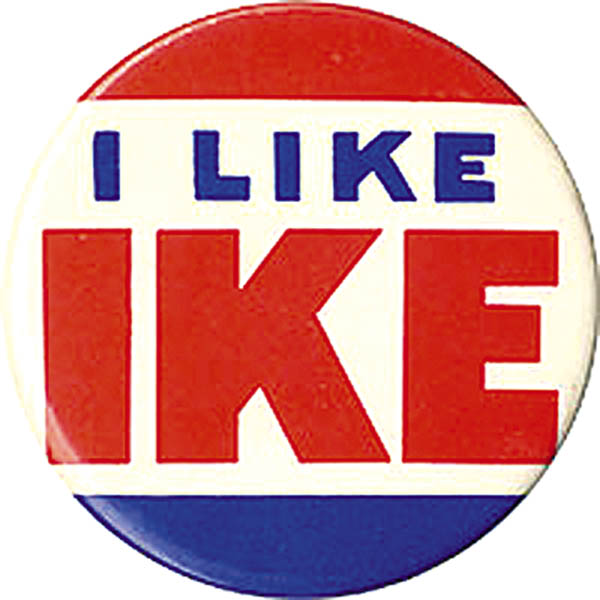American Political Campaign Buttons
Fooled By Fakes
Of all the different types of political collectibles, campaign buttons are the most heavily reproduced. All political collectibles, including campaign buttons, are covered under The Hobby Protection Act, which defines an original political item as "any political button, poster, literature, sticker, or any advertisement produced for use in any political cause." Therefore, a button produced after a campaign is over would not have been made for use in that political cause and is not authentic.
The Act goes on to define the specific parameters that must be met when creating a reproduction of a campaign button so the piece can't be used to deceive buyers: "An imitation political button, poster, literature, sticker, or advertisement composed of nonincusable material shall be imprinted with the calendar year in sans-serif numerals. Each numeral shall have a vertical dimension of not less than two millimeters (2.0 mm). The minimum total horizontal dimension of the four numerals composing the calendar year shall be six millimeters (6.0 mm)." Companies that made reproduction campaign buttons as part of their advertising promotionals would meet these criteria, so begin by checking the button for these telltale marks.
There are three types of non-authentic campaign buttons to watch out for: fakes (counterfeits), fantasies, and re-pins. Fakes are copies of actual buttons made after the fact that are intended to deceive buyers into thinking they're originals that were made and used during the actual political campaign; fantasies are buttons that never existed (sellers of these pieces hope collectors will believe they've discovered a rare or unknown button); and re-pins are celluloid buttons made at some point after the campaign that are actually marriages of original period papers printed during the time of the political campaign joined with more contemporary button materials.
Much like judging the difference between a print and an original in artwork, political buttons with colors that have been made in modern years will most likely have telltale printer dots when viewed through a magnifier. On the other hand, authentic old buttons will have solid coloring. The materials used to make the pin changed throughout the decades. Early pin buttons carried candidates' ferrotype or ambrotype portraits; later these portraits were covered by celluloid. During the 1920s metal buttons carried lithographed images and slogans. A good reference book will give details about the minor and major changes made throughout the years each type of button was made. With this information, you'll spot a reproduction quickly if a more modern method of construction features a candidate from an earlier time.
Since most of the legitimate reproductions made as company promotionals were marked either on the back or on the curl (rounded edge), those are the areas that fraudsters would want to deface. Look for either paint or paper on the back or for what could be deliberate blemishes on the curl, front, or back. Attempts at reproducing colors or copying images rarely, if ever, matches originals exactly. Many times, copies will either use incorrect colors or incorrect color shades - where an original may have had fire engine red stripes, for example, the copy may have a slightly more muted, brighter, or pinker shade of red. The colors may also be in the wrong places. And since many copies were either scanned or photocopied from originals, the edges of letters or images may not be as sharp and clear as they should be and may have a slightly blurred, out-of-focus appearance.
Anyone would get excited at the discovery of a Washington inaugural clothing button, but these have been reproduced as well. Some have authentic age to them, they were made for the 1876 centennial celebration and again in 1889 to commemorate Washington's inauguration, making them over 100 years old. These are legitimate commemorative collectibles but should not be confused with the originals from Washington's time. They were reproduced again in 1976 in pewter and brass with domed surfaces, whereas the original buttons were flat. The later copies also had sharper details and the word "copy" on the back. Anyone trying to misrepresent one of these 1976 buttons as an 18th-century original or a 19th-century commemorative would most likely have tried to scratch the word "copy" off the back, so watch for that as another telltale sign.
Unfortunately, not all reproductions have the identifying marks they should. In the past, a few smaller museums and historical sites were found to be selling reproduction political buttons in their gift shops without the all-important marks indicating a modern reproduction. (The Federal Trade Commission put a stop to the sales of those buttons.) Those outlets were not intending to deceive buyers and the buttons were very inexpensive, but once in the wrong hands, a little false aging can turn an innocent copy into a collector's nightmare. If you do your homework and understand the details of the piece you're interested in, you'll be able to protect yourself from a bad investment.
Lincoln and Willkie campaign button photos via Wikipedia.
At A Glance:
Signs of a fake:
1. Pinback style or materials of a later era than the political campaign represented.
2. Scratching or painting on the back or along an edge to cover reproduction information.
3. Incorrect font size or colors.
4. Incorrect button size.
5. Blurred edges on colored images or lettering.
Reference books, websites, and collecting groups are the best ways to keep from being fooled by fakes. Here are a few: American Political Items Collectors (www.apic.us); Encyclopedia of Political Buttons by Theodore L. Hake; and Price Guide to Collectible Pin-Back Buttons 1896-1986 by Ted Hake and Russ King.
If you have a topic you'd like to see covered here or want to use any Fooled By Fakes content on your website or in print, please email me at FooledByFakes@gmail.com.








